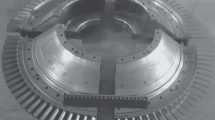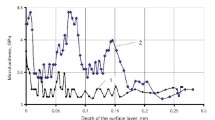A study on the effect of pore space parameters of sintered titanium alloys on the strength margin of gas turbine compressor blades has been carried out. It is shown that the endurance of parts made of sintered titanium alloys synthesized from powder mixtures based on PT5 titanium powder obtained by the mechanical milling of a titanium sponge must be evaluated taking into account the peculiarities of the morphology of the pore space. An approach to taking into account the effect of the peculiarities of the morphology of the pore space on the endurance limit of gas turbine compressor blades has been proposed and experimentally evaluated using an analysis of the fractal dimension of pore boundaries. The results of experimental studies of the endurance limit of specimens of VT1-0, VT6, and VT8 titanium alloys, which have a different porosity, mean pore size and fractal dimension, are presented. A modeling of the stress-strain state of an airfoil of full-scale low-pressure compressor blades of a shaft gas turbine engine has been performed. The results of fatigue tests of full-scale compressor blades are presented. Based on fracture mechanics approaches, an improved model for the estimation of the endurance limit of specimens of sintered titanium alloys taking into account solid phase properties, pore size and morphology, and total porosity is proposed. A relationship relating the strength margin of full-scale compressor blades to the endurance limit of laboratory specimens, their porosity parameters and the loads acting during the operation of gas turbine engines is proposed. A calculation of the strength margin and the probability of non-failure of gas turbine compressor blades made of a sintered titanium alloy with different pore size and shape, and porosity has been made. Their maximum permissible values have been determined, at which the strength margin and the probability of non-failure of blades are provided, which meet the requirements of normative documents. It is shown that to provide the required value of the strength margin and probability of non-failure of blades, the process to manufacture them must include operations aimed at avoiding pores in the surface layer.









Similar content being viewed by others
Change history
15 April 2020
To the article ���Effect of Porosity Parameters on the Strength of Gas Turbine Compressor Blades Made of Titanium Alloys,��� by D. V. Pavlenko, Vol. 51, No. 6, pp. 887���899, November, 2019.
References
C. Haase, R. Lapovok, H. P. Ng, and Y. Estrin, “Production of Ti–6AI–4V billet through compaction of blended elemental powders by equal-channel angular pressing,” Mater. Sci. Eng. A, 550, 263–272 (2012).
Y. Torres, J. J. Pavón, I. Nieto, and J. A. Rodriguez, “Conventional powder metallurgy process and characterization of porous titanium for biomedical applications,” Metall. Mater. Trans. B, 42, No. 4, 891–900 (2011).
P. Edwards, A. O’Conner, and M. Ramulu, “Electron beam additive manufacturing of titanium components: Properties and performance,” J. Manuf. Sci. Eng., 135, 1–7 (2013).
O. M. Ivasishin, D. G. Savvakin, F. Froes, et al., “Synthesis of Ti–6Al–4V alloy with low residual porosity by the powder metallurgy technique,” Poroshk. Metallurg., Nos. 7–8, 54–64 (2002).
D. G. Savvakin, K. A. Bondareva, I. S. Belov, et al., “Chemical homogenization processes in the synthesis of Ti–6Al–4V alloy from elemental mixtures,” Metallofiz. Nov. Tekhnol., 26, No. 5, 675–690 (2004).
O. M. Ivasishin, D. G. Savvakin, V. S. Moxson, et al., “High integrity, low cost titanium powder metallurgy components,” in: F. H. (Sam) Froes, E. Y. Chen, R. R. Boyer, et al. (Eds.), High Performance Metallic Materials for Cost Sensitive Applications, TMS, Warrendale (2002), pp. 117–128.
I.-H. Oh, N. Nomura, N. Masahashi, and S. Hanada, “Mechanical properties of porous titanium compacts prepared by powder sintering,” Scripta Mater., 49, No. 12, 1197–1202 (2003).
C.-W. Lin, C.-P. Ju, and J.-H. Chern Lin, “A comparison of the fatigue behavior of cast Ti–7.5Mo with titanium, Ti–6Al–4V and Ti–13Nb–13Zr alloys,” Biomaterials, 26, No. 16, 2899–2907 (2005).
S. A. Yavari, R. Wauthle, J. van der Stok, et al., “Fatigue behavior of porous biomaterials manufactured using selective laser melting,” Mater. Sci. Eng. C, 33, No. 8, 4849–4858 (2013).
S. Leuders, M. Thöne, A. Riemer, et al., “On the mechanical behavior of titanium alloy TiA16V4 manufactured by selective laser melting: Fatigue resistance and crack growth performance,” Int. J. Fatigue, 48, 300–307 (2013).
V. A. Boguslaev, F. M. Muravchenko, P. D. Zhemanyuk, et al., Technological Support of the Operating Characteristics of GTE Parts. Turbine Blades [in Russian], OJSC “Motor Sich”, Zaporozhye (2007).
P. I. Kudryavtsev, Nonpropagating Fatigue Cracks [in Russian], Mashinostroenie, Moscow (1982).
O. M. Ivasishin, K. A. Bondareva, V. I. Bondarchuk, et al., “Fatigue resistance of powder metallurgy Ti–6Al–4V alloy,” Strength Mater., 36, No. 3, 225–230 (2004).
V. T. Troshchenko, “Threshold fatigue and fretting fatigue of metals,” Strength Mater., 32, No. 5, 427–433 (2000).
V. T. Troshchenko, “Investigation into threshold stress intensity factors of materials under cyclic loading. Report 1. Methods and experimental results,” Strength Mater., 30, No. 4, 355–363 (1998).
V. T. Troshchenko, “Investigation into threshold stress intensity factors of materials under cyclic loading. Report 2. Prediction of fatigue limits and fatigue crack growth,” Strength Mater., 30, No. 5, 455–459 (1998).
V. N. Antsiferov, Yu. V. Sokolkin, A. A. Chekalkin, et al., “Numerical model of the fatigue life of a powder material,” Poroshk. Metallurg., Nos. 5–6, 112–118 (1994).
V. T. Troshchenko and S. M. Lyalikov, “The influence of surface defects on high-cycle fatigue of engineering materials,” Strength Mater., 28, No. 1, 1–9 (1996).
V. T. Troshchenko, A. V. Prokopenko, and S. M. Lyalikov, “Effect of residual stresses on the fatigue resistance of structural steels and alloys containing surface defects,” Strength Mater., 21, No. 8, 975–981 (1996).
V. T. Troshchenko, L. A. Khamaza, V. V. Pokrovdkii, et al., Cyclic Strains and Fatigue of Materials [in Russian], Vol. 2: Life of Metals with Allowance for Operational and Technological Factors, Naukova Dumka, Kiev (1985).
S. N. Kul’kov, J. Tomað, and S. P. Buyakova, “Fractal dimension of surfaces of porous ceramic materials,” Tech. Phys. Lett., 32, No. 1, 73–75 (2006).
L. M. Shkol’nik, Fatigue Test Procedure. Handbook [in Russian], Metallurgiya, Moscow (1978).
A. Yu. Kem and L. A. Arestova, “Peculiarities of aggregate consolidation and fractal dimension of the surface of Al–Cu powder materials based on granulated aluminum,” Vestn. DGTU, 10, No. 2 (45), 189–199 (2010).
A. N. Aitimbetova and O. N. Kanygina, “Fractal dimension of the pore space surface of wollastonite ceramics,” Vestn. KRSU, 10, No. 10, 118–123 (2010).
D. V. Pavlenko, “Effect of titanium powder parameters on the strength of sintered semifinished products,” Nov. Mater. Tekhnol. Metalurg. Mashynobud., No. 2, 87–92 (2014).
Aviation Regulations. Airworthiness Standards for Aircraft Engines [in Russian], Part 33, Interstate Aviation Committee (2004).
S. V. Serensen (Ed.), V. P. Kogaev, and R. M. Shneiderovich, Load-Carrying Ability and Strength Design of Machinery Parts. Guide and Reference Manual [in Russian], Mashinostroenie, Moscow (1975).
S. V. Serensen, Quasi-Static and Fatigue Failure of Materials and Structural Elements [in Russian], Vol. 3, Naukova Dumka, Kiev (1985).
V. T. Troshchenko and L. A. Sosnovskii, Fatigue Resistance of Metals and Alloys. Handbook [in Russian], Part 1, Naukova Dumka, Kiev (1987).
I. A. Birger (Ed.), B. F. Balashov (Ed.), R. A. Dul’nev, et al., Structural Strength of Materials and Parts of Gas Turbine Engines [in Russian], Mashinostroenie, Moscow (1981).
Author information
Authors and Affiliations
Corresponding author
Additional information
Translated from Problemy Prochnosti, No. 6, pp. 90 – 105, November – December, 2019.
Rights and permissions
About this article
Cite this article
Pavlenkoz, D.V. Effect of Porosity Parameters on the Strength of Gas Turbine Compressor Blades Made of Titanium Alloys. Strength Mater 51, 887–899 (2019). https://doi.org/10.1007/s11223-020-00139-0
Received:
Published:
Issue Date:
DOI: https://doi.org/10.1007/s11223-020-00139-0




